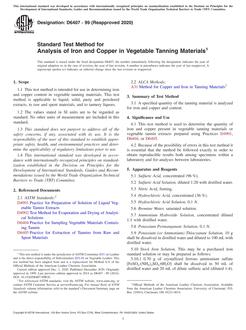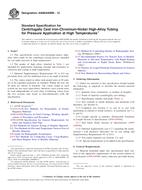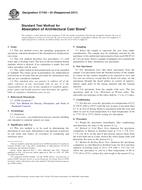1.1 This practice establishes two procedures for ultrasonic testing (UT) of flat panel composites and flat sandwich core panels (parallel surfaces). Typical as-fabricated lay-ups include uniaxial, cross ply and angle ply laminates; as well as honeycomb sandwich core materials. These procedures can be used throughout the life cycle of the materials; product and process design optimization, on line process control, after manufacture inspection, and in service inspection. Contact methods such as angle-beam techniques using shear waves, or surface-beam techniques using Lamb waves, are not discussed.
1.2 Ultrasonic testing is a common sub surface method for detection of laminar oriented discontinuities. Two techniques can be considered based on panel surface accessibility; pulse echo for one sided and through transmission (bubblers/squirters) for two sided. As used in this practice, both require the use of a pulsed straight-beam ultrasonic longitudinal wave followed by observing indications of either the reflected (pulse-echo) or received (through transmission) wave. The general types of anomalies detected by both techniques include foreign materials, delamination, disbond/un-bond, fiber de-bonding, inclusions, porosity, and voids.
1.3 This practice provides two ultrasonic test procedures. Each has its own merits and requirements for inspection and shall be selected as agreed upon in a contractual document.
1.3.1 Test Procedure A, Pulse Echo (non-contacting and contacting), is at a minimum a single transducer transmitting and receiving a longitudinal wave in the range of 0.5 to 20 MHz (see Fig. 1). This procedure requires access to only one side of the specimen. This procedure can be conducted by automated or manual means. Automated and manual test results may be imaged or recorded.
1.3.2 Test Procedure B, Through Transmission, is a combination of two transducers. One transmits a longitudinal wave and the other receives the longitudinal wave in the range of 0.5 MHz to 20 MHz (see Fig. 2). This procedure requires access to both sides of the specimen. This procedure is automated and the examination results are recorded.
1.4 This practice does not specify accept-reject criteria.
1.5 This standard does not purport to address all of the safety concerns, if any, associated with its use. It is the responsibility of the user of this standard to establish appropriate safety and health practices and determine the applicability of regulatory limitations prior to use.

FIG. 1 Test Procedure A, Pulse Echo Apparatus Set-up

FIG. 2 Test Procedure B, Through Transmission Apparatus Set-up
Product Details
- Published:
- 06/15/2012
- Number of Pages:
- 7
- File Size:
- 1 file , 200 KB
- Redline File Size:
- 2 files , 390 KB


